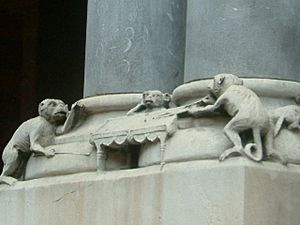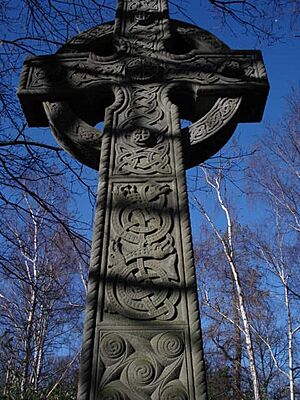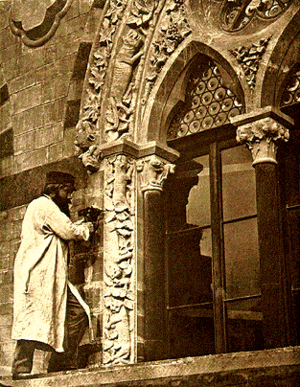O'Shea and Whelan facts for kids
O'Shea and Whelan was a family business of skilled stonemasons and sculptors from Ballyhooly in County Cork, Ireland. They became famous in the mid-1800s for their detailed stone carvings on buildings, especially in the gothic architecture style that John Ruskin helped to make popular.
Meet the O'Shea and Whelan Carvers
The main people in the business were brothers James and John O'Shea, and their nephew Edward Whelan. Their father was also a craftsman who moved to Cork and started a workshop in Ballyhooly. When he passed away, James and John took over the workshop. People often called them "The O'Shea Brothers."
However, Edward Whelan was also a very important part of the team. Even so, James O'Shea was the most well-known member of the family. Besides carving for buildings, he also created beautiful sculptures in a classical style, like those from ancient Greece and Rome.

The O'Sheas first became known for their amazing carvings of flowers and funny, strange creatures (called grotesques) on buildings in Dublin. Some of their famous works can be seen at Trinity College and the Kildare Street Club. One very famous carving at the Kildare Street Club shows club members as monkeys playing billiards!
Working with John Ruskin
Around this time, a famous art critic named John Ruskin wanted to bring back a lively, freehand style of stone carving. This style was common in medieval Gothic buildings. Architects Thomas Newenham Deane and Benjamin Woodward were planning to work with Ruskin on a new building: the Oxford University Museum of Natural History.
Woodward had worked with the O'Sheas in Dublin. He knew they were the best carvers for the job. So, he brought them to Oxford. The O'Sheas worked closely with Ruskin and the architects. They created many detailed carvings of plants and animals. Each carving was unique and special.

James O'Shea also tried to become a famous artist with Ruskin's help. However, Ruskin later said he was "disappointed" with James's artwork. Ruskin felt that the freedom James had in his carving actually made it harder for him to grow as a fine artist.
More problems came up when the university leaders (called the Convocation) refused to pay for more carvings. These carvings had mostly been paid for by donations from the public. When the O'Sheas offered to work for free, some university members accused them of "damaging" the building with carvings that weren't approved.
According to Henry Acland, a professor who worked with Ruskin, James O'Shea carved funny pictures of the university members. He made them look like parrots and owls at the building's entrance. Acland made him remove the heads of these carvings. Even today, you can still see where they were removed.
Other Notable Projects
The O'Sheas also worked on several other buildings. One of the O'Sheas carved statues for St Mary's church in Rhyl, Wales. Another worked for the architect J.F. Bentley. Bentley described the carver's attitude as "unbearable." Later, Thomas Deane hired Edward Whelan to work on the Meadow Building in Oxford and at the Fleet Street Crown Life Office.
Thomas Woolner, another sculptor involved in the Oxford project, hired James O'Shea to create carvings for his home. The O'Sheas and Whelan then worked with Woolner and architect Alfred Waterhouse. They helped design the Manchester assize courts. Here, they created carvings that showed gruesome forms of punishment from history. The original building was destroyed by bombs in World War Two. However, the carvings were saved and are now in the new building.
James O'Shea eventually returned to Ireland. He worked in Callan as a sculptor who made monuments, especially Celtic crosses. He started a new business with his son, Edward. A beautiful example of his work is the Celtic cross made to remember the children's author Talbot Baines Reed. This cross stands in Abney Park Cemetery in Stoke Newington, London.


